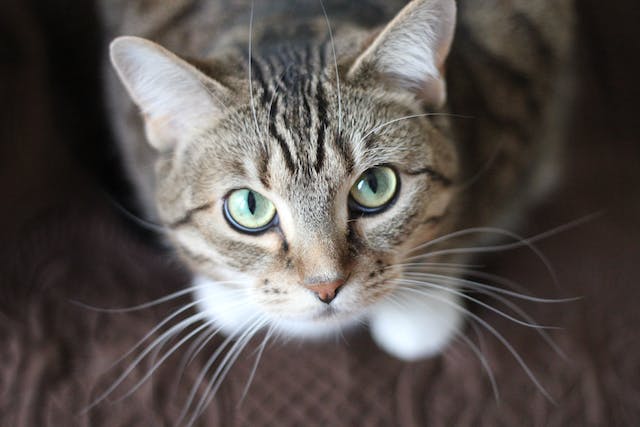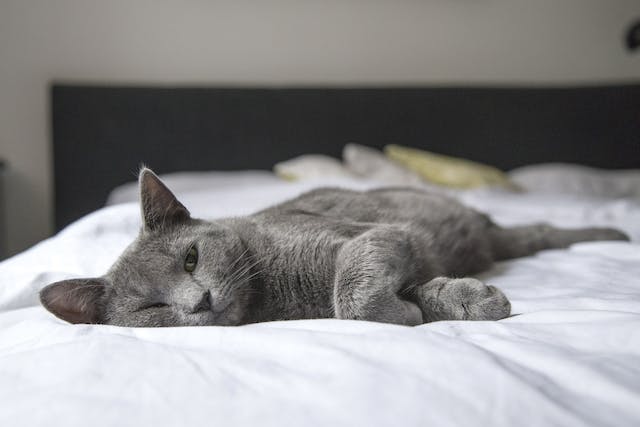Pet Insurance Review > Pet Wellness Guides > Cat Arthritis: Causes, Symptoms & Treatment - Pet Insurance Review
Cat Arthritis: Causes, Symptoms & Treatment
Posted: 03/18/2024 | BY: Jenna Bruce | Categories: Behavior , Cat , Health problems
As our cats age, they experience many of the same health conditions we do, with cat arthritis being one. Older cats with arthritis have a harder time getting around because of stiff and painful joints. While there is no cure for cat arthritis, there are things you can do to help your fur baby feel better.

Symptoms of Cat Arthritis
In young, healthy joints, bones are protected by cartilage and joint fluid. This allows the bones to easily slide past each other without friction. With cat arthritis, the cartilage is often worn down, allowing the bones to grind against each other.
Symptoms of arthritis in cats include:
- Reluctance or hesitance to jump up or down
- Difficulty going up or down stairs
- Limping
- Stiffness in the legs, especially after resting or sleeping
- Difficulty using their litter box
- Irritability
- Reduced levels of activity
- Less time spent on their grooming
- Reduced height when jumping
- Hiding or sleeping more than normal
Causes of Arthritis in Cats
The following are some of the most common factors that increase a cat’s chances of developing arthritis:

Age
Simple wear and tear over the lifespan of a cat can weaken the joints. Getting older isn’t easy for people or cats!
Abnormalities
Some cats may experience abnormal hip and elbow development in their early years, causing the cartilage and joints to not work properly.
Find & Compare the Top Pet Insurance Companies
Get Quotes for Your CatInjuries
You may know someone in your life who played sports in their younger years, sustained many injuries, and their joints are now paying the price. While your cat may not have played football or hockey, they may still have experienced a joint fracture or injury. Once the joint has been damaged, it is far more likely to be a source of pain and stiffness in the future.
Obesity
Extra weight on a cat’s body can cause wear and tear on their joints.
Genetics
Certain breeds of cats, such as Maine Coons, Persians and Siamese, have a genetic predisposition to developing arthritis.
How is Cat Arthritis Treated?
If your sweet fur baby’s life has taken a hit because of cat arthritis, there are a few different ways it can be treated:
Non-Steroidal Anti-Inflammatory Drugs (NSAIDs)
By far the most common treatment for cat arthritis is NSAIDs. These work by reducing the inflammation in the joints and can be prescribed by your veterinarian.
Pain Medications
In some cases, NSAIDs may not be enough to relieve a cat’s pain and get them moving again. If your cat’s arthritis is more severe, your vet may decide to prescribe a pain killing medication.
Injectable Joint Protectants
Glycosaminoglycans, or GAGs, play a key role in joint health. Your vet may recommend these injections for your cat, which are usually given every four weeks.
Acupuncture
Acupuncture, an Ancient Chinese healing practice, has been used for centuries in treating people with all kinds of ailments, including arthritis. Though there are few studies regarding acupuncture for cat arthritis, there are plenty of anecdotal data points that suggest it works just as well for our fur babies as it does for us in relieving pain!
Cold Laser Therapy
This is a noninvasive and painless treatment where a vet moves a small device across the cat’s body. This special device emits therapeutic light waves that have been shown to ease pain and decrease inflammation.
Other Ways You Can help a Cat with Arthritis
In addition to working with your vet to find the right treatment plan, there are some things you can do at home to make your cat’s environment more comfortable for them:
Purchase a soft, warm orthopedic bed made of dense foam that will support your cat’s joints while they rest.
Provide ramps or steps up to places your cat likes to rest, such as the sofa, your bed or a window seat.
Use litter boxes that have one low side so your cat can enter and exit easily.
If you have multiple levels to your house, keep everything on one level (litter box, food and water bowls, bed, etc.) on one floor.
Feed them the right foods and amounts so they maintain a healthy weight. This will put less stress on their achy joints.
Final Thoughts
If your cat is getting up there in age, there’s a very good chance they have begun to experience joint pain and stiffness. Most cats will not show you when they are sick or in pain. It’s up to us to pay close attention to notice any of those symptoms we mentioned. The earlier you detect any changes in your cat’s mobility or behavior, the sooner your vet can prescribe a treatment and the better your feline friend will feel.
Help Your Cat Feel Better with a Pet Insurance Plan
Cat arthritis is just one health condition our fur babies may face as they age. So it’s important we ensure we are financially prepared to handle whatever medical care they may require. From arthritis to kidney disease to heart issues and cancer, taking care of an aging pet can be pricey.
A pet insurance plan will help reimburse you for those vet bills. And sometimes by as much as 90%!
If you’re unsure of the best pet insurance providers in the market, here are the top pet insurance providers – in order – based on over 150,000 authentic reviews from pet parents just like you:
Top Pet Insurance Providers of 2024
| Rating | Provider | Total Review |
|---|---|---|
| 4.9 | Embrace | 10,254 |
| 4.9 | Healthy Paws | 7,440 |
| 4.9 | Fetch | 171 |
| 4.9 | Lemonade | 755 |
| 4.8 | Trupanion | 55,003 |
| 4.8 | Nationwide | 21,391 |
| 4.7 | ASPCA | 5,685 |
| 4.7 | Hartville | 164 |
| 4.7 | MetLife | 390 |
| 4.7 | PetPartners | 98 |
| 4.7 | Spot | 159 |
| 4.5 | Pets Best | 7,175 |
| 4.4 | AKC | 889 |
| 4.4 | Figo | 586 |
| 4.3 | Pet Assure | 12 |
| 4.3 | Pumpkin | 54 |
| 3.2 | ManyPets | 9 |
References:
- https://www.sciencedirect.com/science/article/pii/S2005290118304655
- https://www.petmd.com/cat/conditions/musculoskeletal/arthritis-cats
- https://www.fda.gov/animal-veterinary/animal-health-literacy/osteoarthritis-cats-more-common-you-think
The information contained on this blog is intended for informational and educational purposes only and should not be construed as medical advice. It is not a substitute for professional veterinary care. Always consult with your veterinarian before making any changes to your pet's health care or treatment plan.
The authors of this blog are not veterinarians and do not claim to be experts in pet health. The information provided here is based on our own experiences and research, as well as information from reputable sources. However, we cannot guarantee the accuracy or completeness of this information.
We encourage you to do your own research and consult with your veterinarian before making any decisions about your pet's health.